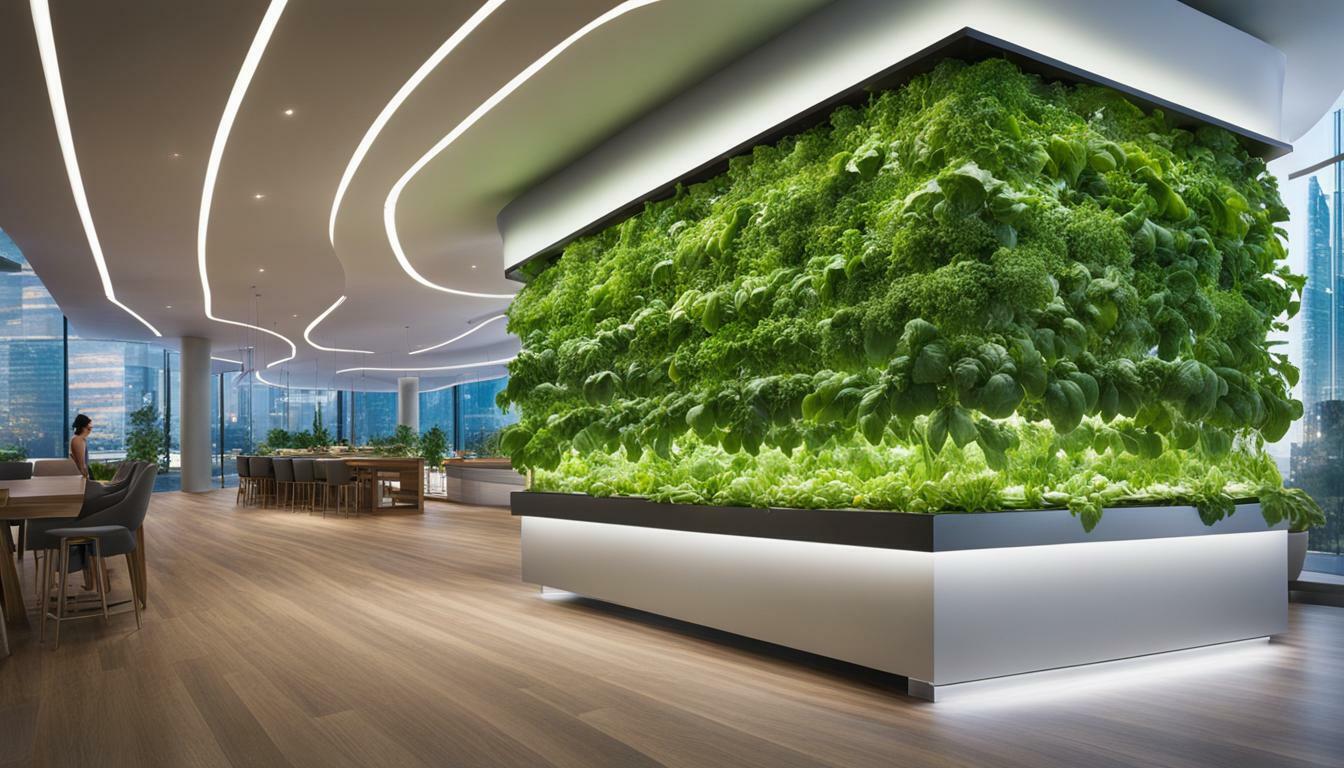Vertical indoor hydroponic gardening is a cutting-edge green technology that allows for superior growth and yield year-round, making it the perfect solution for indoor gardening enthusiasts and urban gardeners alike. This innovative approach to gardening eliminates the need for soil, instead utilizing nutrient-rich water solutions to deliver optimal nutrition directly to plant roots. By utilizing vertical space, these hydroponic systems efficiently maximize the use of limited indoor or outdoor areas. Whether you’re looking to grow indoor plants, create an indoor herb garden, or cultivate your own vegetables, a vertical hydroponic garden offers numerous benefits that can elevate your gardening experience.
Key Takeaways:
- Vertical indoor hydroponic gardening provides superior growth and yield year-round.
- It eliminates the need for soil and utilizes nutrient-rich water solutions.
- Vertical hydroponic gardens optimize limited indoor or outdoor space.
- They are ideal for indoor plants, herb gardens, and vegetable cultivation.
Advantages of Vertical Hydroponics
Vertical hydroponics offers a multitude of advantages that make it a game-changer in indoor gardening. From maximizing space utilization to increasing efficiency and productivity, this innovative approach to cultivation is revolutionizing the way plants are grown.
Space Savings
One of the primary benefits of vertical hydroponics is its ability to optimize limited space. In urban areas where floor space is scarce, vertical systems provide an excellent solution for indoor gardening. By utilizing vertical space, these systems can fit into small corners or outdoor patios, making them less intrusive while still allowing for efficient crop production. This makes vertical hydroponics a viable option for urban homes and small spaces where traditional soil-based gardening may not be feasible.
Furthermore, the absence of soil in hydroponic systems allows plants to be grown much closer together compared to traditional methods. In a hydroponic setup, plant roots are suspended directly in nutrient-rich solution, significantly reducing the need for extensive root spread. As a result, vertical hydroponics enables efficient use of space by maximizing the number of plants that can be grown in a given area.
Lack of Soil
Another advantage of vertical hydroponics is the innovative alternative it provides to traditional soil-based agriculture. By eliminating the need for soil, this method allows for cultivation in various environments where arable land is limited, such as dry or arid climates. Vertical hydroponics also offers a solution to soil erosion caused by climate change and destructive farming practices, promoting sustainable and environmentally-friendly cultivation.
In addition, vertical hydroponics can address food production challenges in coastal areas with limited access to fresh water. Through the use of desalination technology, it becomes possible to extract fresh water from the ocean, enabling hydroponic gardens and agricultural practices in water-scarce regions.
Furthermore, the controlled and soil-free environment of hydroponics minimizes the presence of weeds, pests, and plant diseases. This reduces the need for chemical fertilizers, fungicides, and pesticides, resulting in safer and healthier produce. In many cases, harvested crops from hydroponic systems may not require washing, as they are grown in clean and controlled conditions.
Efficiency & Productivity
Efficiency and productivity are key advantages of vertical hydroponic systems. The delivery of hydroponic nutrients in direct contact with plant roots ensures optimal uptake and fast growth. Unlike plants grown in soil, where roots must search for nutrients, hydroponic plants receive an exact quantity of nutrition at all times. This targeted approach allows plants to utilize their energy for productive growth, rather than developing large root systems.
Indoor vertical hydroponics, in particular, offers enhanced control over temperature, light, air composition, and pest management. This controlled environment maximizes crop growth rates, quality, and yield, allowing for year-round production of various crops. Additionally, the weight of upper layers in vertical hydroponic systems is reduced by up to 30% compared to using soil, enabling the stacking of more layers and further optimizing space utilization.
Low Maintenance
Vertical hydroponics systems are known for their low maintenance requirements. In a well-constructed system, water and nutrients remain contained within the tubes, preventing spillage or leakage. The closed-loop system ensures optimal usage and minimal wastage, making it environmentally friendly and efficient.
Hydroponic systems conserve water by recirculating it until it is no longer usable, significantly reducing water consumption compared to traditional soil-based agriculture. In fact, recirculating hydroponic systems can conserve up to 80% of water and use up to 10 times less water than standard garden beds. This water conservation is especially crucial in regions facing water scarcity issues, where field-based agriculture contributes to significant freshwater depletion.
Water Flow
One challenge in vertical hydroponics systems is ensuring adequate water flow to all levels of plants. Since the plants are stacked vertically, water needs to be delivered vertically as well, often requiring powerful pumps to overcome gravitational forces. Without proper water flow, lower plants may be at risk of drowning, while upper plants may suffer from insufficient water supply.
Another crucial aspect of vertical hydroponics is lighting. In outdoor systems, sunlight can be utilized to provide adequate light to plants. However, indoor setups require artificial grow lights to ensure optimal plant growth. Proper placement and quality of lighting are essential to ensure uniform light distribution and meet the specific light requirements of different crops.
Buying vs. DIY
When considering vertical hydroponic systems, individuals face the decision of purchasing pre-made systems or embarking on a DIY project. Buying pre-made systems offers convenience and support, as these systems come ready to assemble and use, often with warranties and customer support. On the other hand, building a DIY system allows for customization and creative freedom, catering to specific needs and budget constraints. The choice between buying and DIY ultimately depends on technical abilities, available time, and individual preferences.
Conclusion:
Vertical hydroponics provides numerous advantages, including space savings, lack of soil, increased efficiency and productivity, low maintenance, and water conservation. These benefits make vertical hydroponics an attractive option for indoor gardening, urban farming, and sustainable crop production. Whether through pre-made systems or DIY projects, individuals can harness the power of vertical hydroponics to achieve superior growth, optimize space, and promote sustainable agriculture.
Space Savings
One of the key benefits of vertical hydroponics is its space-saving design, making it an excellent choice for indoor gardening in small spaces. The vertical orientation of these systems allows for efficient utilization of limited floor space, maximizing the number of plants that can be grown in a confined area.
By stacking plants vertically, such as in stacked hydroponic systems or vertical towers, growers can take advantage of unused vertical space, making the most of every square inch. This is especially beneficial for urban gardeners or those with limited outdoor space, as it allows them to grow a significant amount of crops without needing a large garden or plot of land.
In addition to saving floor space, vertical hydroponics also allows for closer plant spacing compared to traditional soil-based gardening. The roots of plants in hydroponic systems do not need to spread out in search of nutrients, as they are directly suspended in nutrient-rich solutions. This means that crops can be grown in close proximity to each other, further maximizing space utilization.
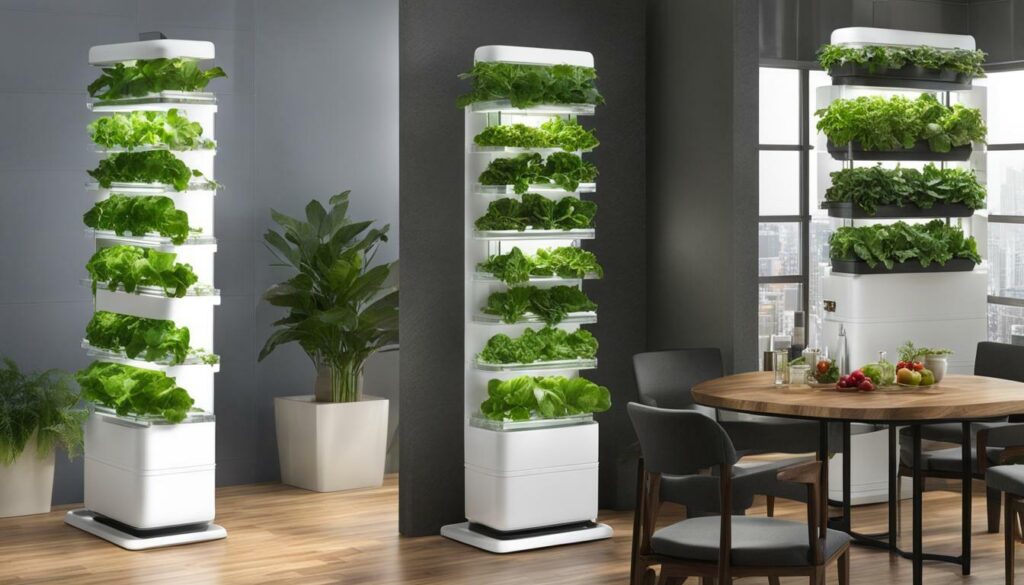
Overall, vertical hydroponics offers a practical solution for indoor gardening in small spaces. Whether it’s in a corner of a room, on a patio wall, or inside a spare room, these systems provide an efficient way to grow a variety of plants without the need for a large outdoor garden.
| Benefits of Space Savings in Vertical Hydroponics |
|---|
| Maximizes limited floor space in indoor gardening |
| Allows for closer plant spacing, optimizing space utilization |
| Enables vertical growth, making the most of unused vertical space |
| Great option for urban gardeners or those with limited outdoor space |
With the space-saving benefits of vertical hydroponics, even those living in apartments or small homes can enjoy the satisfaction of growing their own fresh herbs, vegetables, or ornamental plants. The ability to optimize space utilization is a game-changer for urban agriculture and indoor gardening enthusiasts.
Lack of Soil
Hydroponics, with its lack of soil, offers an innovative alternative to traditional farming practices, making it a sustainable solution for growing crops in various challenging conditions. This soil-free approach to agriculture has gained popularity due to its numerous advantages, including:
- Minimization of Soil Erosion: By eliminating the need for soil, hydroponics helps combat the issue of soil erosion, which can have detrimental effects on agricultural productivity and the environment. This is particularly important in areas where arable land is limited or prone to erosion.
- Water Scarcity Solutions: Hydroponic systems allow for efficient water usage, reducing water consumption compared to conventional farming. In areas with limited access to freshwater sources, such as coastal regions, hydroponics can provide a sustainable method of cultivation by utilizing alternative water sources, like desalinated water from the ocean.
- Reduced Use of Chemicals: The controlled and soil-free environment of hydroponics minimizes the risk of weeds, pests, and diseases, reducing the need for chemical fertilizers, fungicides, and pesticides. This not only promotes food safety but also contributes to the overall reduction of chemical usage in agriculture.
Hydroponics offers an innovative approach to agriculture that addresses the challenges posed by soil limitations, soil erosion, water scarcity, and chemical dependencies. By providing an alternative method of cultivation, hydroponics paves the way for sustainable and environmentally friendly farming practices.
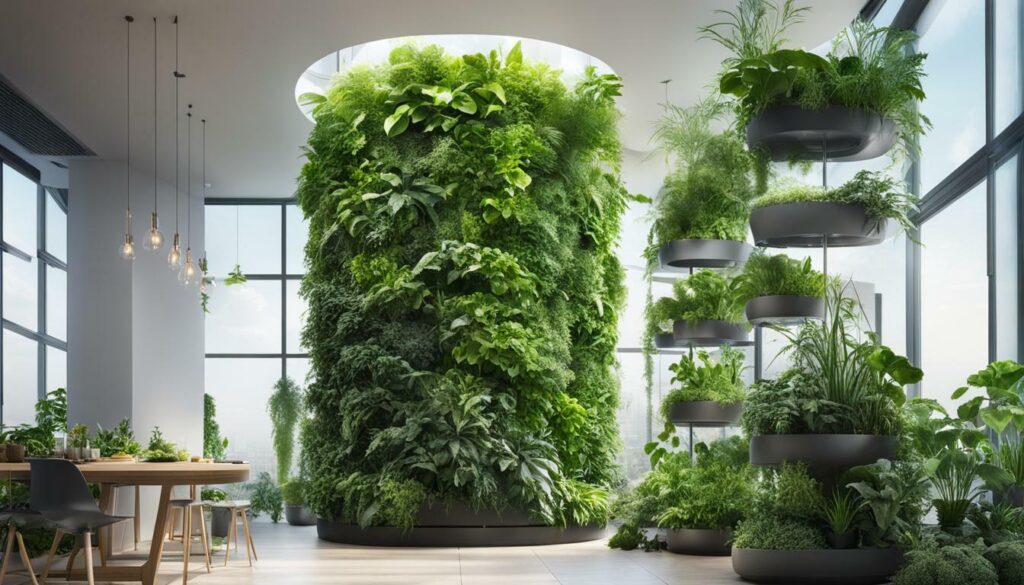
Efficiency & Productivity
The efficiency and productivity of hydroponics are unparalleled, thanks to the direct delivery of nutrients to plant roots and the ability to create controlled environments that maximize growth rates. Hydroponic nutrients, derived from mineral salts, are readily available and result in optimal growth and faster maturity compared to traditional soil-based methods. This is because the nutrients in hydroponic systems are fast-release with fast uptake, ensuring that plants receive exactly what they need when they need it.
In soil-based systems, plant roots spread out in search of nutrients, leading to larger root systems. In hydroponics, the nutrients are delivered directly to the root system, allowing plants to allocate energy to producing foliage, stems, leaves, and fruit rather than large root systems. This efficient nutrient delivery system promotes plant growth, leading to higher yields and better quality produce.
Vertical hydroponics, especially in controlled indoor environments, enables growers to have better control over temperature, lighting, air composition, and pests. This level of control results in maximized crop growth rates and year-round availability of most crops. By utilizing vertical hydroponics, growers can stack more layers on top of each other, optimizing space utilization and increasing overall productivity.
Maximizing Growth Potential
With the ability to customize lighting, humidity, and nutrient levels, vertical hydroponic systems provide an optimal environment for plants to thrive. By providing plants with the exact quantities of nutrients they need, these systems prioritize foliage, stem, leaf, and fruit production, resulting in faster growth rates and higher yields. The controlled environment in vertical hydroponics also minimizes the risk of pests and diseases, reducing the need for chemical intervention and promoting healthier, safer produce.
| Crop | Optimal Growth Conditions |
|---|---|
| Lettuce | Temperature: 55-70°F, Light: 12-14 hours per day |
| Tomatoes | Temperature: 70-80°F, Light: 14-18 hours per day |
| Herbs (Basil, Mint, etc.) | Temperature: 60-70°F, Light: 12-16 hours per day |
| Strawberries | Temperature: 60-70°F, Light: 12-16 hours per day |
By utilizing vertical hydroponic systems, growers can take advantage of efficient space utilization, customizable environments, and direct nutrient delivery. These factors contribute to increased efficiency and productivity, allowing for year-round crop production and higher yields. With the ability to grow a variety of crops in these systems, growers can maximize their growth potential and cultivate fresh, healthy produce in a sustainable and controlled manner.
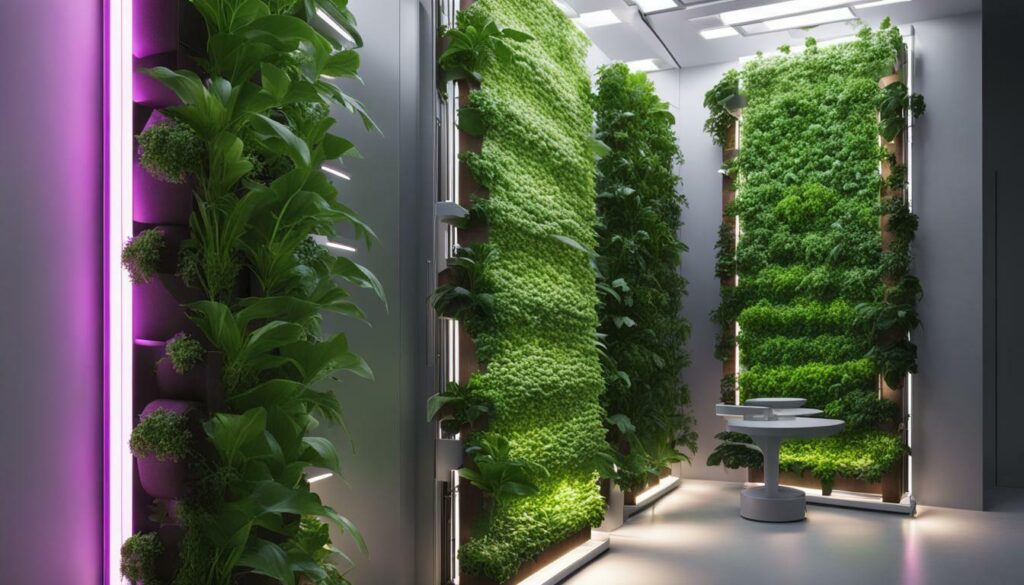
Low Maintenance
Vertical hydroponics requires minimal maintenance, thanks to its closed-loop system that conserves water and minimizes resource wastage. This system ensures that the water and nutrients stay within the hydroponic setup, eliminating spillage or leakage. Additionally, the water in a vertical hydroponic system is constantly recycled, reducing water usage and maximizing efficiency.
Compared to traditional soil-based gardening, vertical hydroponics offers a sustainable advantage in water conservation. In fact, a recirculating hydroponic system can conserve up to 80% of water and use up to 10 times less water compared to a standard garden bed. This is especially crucial in areas where water shortage is a significant concern, as field-based agriculture is one of the largest consumers of freshwater sources.
A closed-loop system not only minimizes water wastage but also reduces the need for chemical fertilizers, fungicides, and pesticides. With the controlled and soil-free environment of vertical hydroponics, the occurrence of weeds, pests, and plant diseases is significantly minimized. As a result, the reliance on chemical interventions is drastically reduced, promoting food safety and reducing the need for extensive cleaning and washing of harvested crops.
Table: Comparison of Maintenance Needs in Vertical Hydroponics vs. Traditional Soil-Based Gardening
| Vertical Hydroponics | Traditional Soil-Based Gardening | |
|---|---|---|
| Water Usage | Up to 80% water conservation | Higher water consumption |
| Chemical Use | Reduced reliance on chemical fertilizers, fungicides, and pesticides | Potential need for chemical interventions |
| Pest and Disease Control | Minimized occurrence of weeds, pests, and plant diseases | Potential risk of weeds, pests, and plant diseases |
| Cleaning and Washing | Minimal cleaning and washing of harvested crops | Potential need for extensive cleaning and washing of harvested crops |
Vertical hydroponics offers a low-maintenance solution for indoor gardening, making it an ideal choice for those with limited time or gardening experience. With its closed-loop system, water conservation, and reduced reliance on chemicals, vertical hydroponics not only simplifies the gardening process but also contributes to sustainable and efficient crop production.
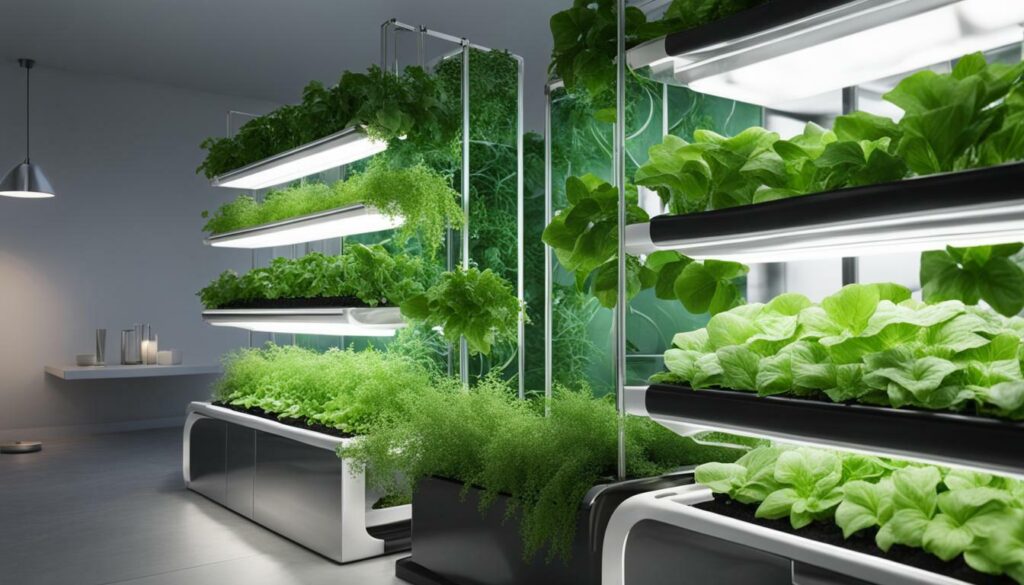
Water Flow
Ensuring proper water flow is crucial in vertical hydroponics systems, as it requires adequate water delivery against the force of gravity and strategic lighting arrangements. In these systems, water needs to be distributed vertically to all levels to ensure all plants receive the necessary nutrients, while avoiding the pooling of water at the bottom that can drown lower plants.
One of the main challenges in achieving optimal water flow is the need for pumps with higher power to send the water up against gravity. These powerful pumps are necessary to ensure that water reaches the top levels of the system and is evenly distributed throughout.
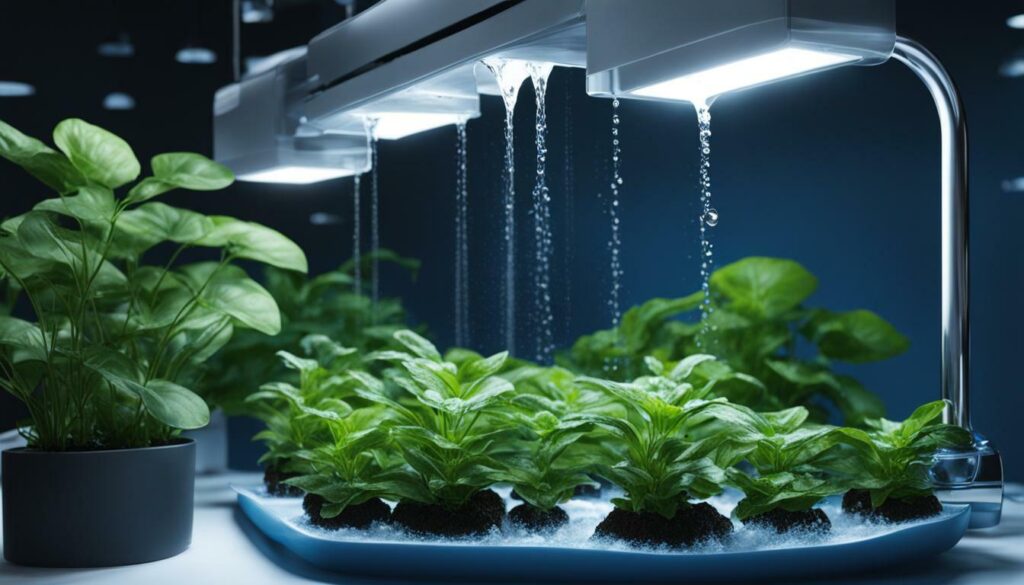
In addition to water flow, lighting is another important consideration in vertical hydroponics systems, especially when they are set up indoors. Since vertical gardens may not have sufficient access to natural sunlight, electric grow lights are often used to provide the necessary light for plant growth.
Lighting Requirements
The lighting requirements in vertical hydroponics systems can vary depending on the specific plants being grown. Different crops have different lighting needs, including the intensity and duration of light exposure. For example, peppers require up to 18 hours of light per day and need to be in close proximity to the light source to thrive.
To ensure equal light distribution, multiple vertically mounted lights are often used to cover all the growing surfaces uniformly. This arrangement helps to optimize the lighting conditions for each plant in the vertical system, allowing for maximum growth and yield.
Table: Recommended Lighting Durations for Different Crops
| Crop | Recommended Lighting Duration |
|---|---|
| Lettuce | 12-14 hours |
| Tomatoes | 14-16 hours |
| Herbs | 16-18 hours |
| Peppers | 14-18 hours |
By ensuring proper water flow and meeting the lighting requirements, vertical hydroponics systems can provide the optimal growing conditions for plants. These systems allow for efficient use of space and maximize crop growth rates, making them an excellent choice for urban gardening and sustainable agriculture.
Buying vs. DIY
When it comes to vertical hydroponic systems, individuals have the option of purchasing pre-made setups or embarking on a DIY project, each with its own merits and considerations. Let’s take a closer look at the advantages of both options.Advantages of Purchasing Pre-Made Systems:Purchasing a pre-designed vertical hydroponic system offers convenience and support for growers. These systems come ready to assemble and use, saving time and effort, especially for beginners or those without technical skills. Additionally, pre-made systems often come with warranties, customer support, and detailed instructions, ensuring a smoother experience.
Advantages of DIY Systems:Opting for a DIY approach to vertical hydroponics provides creative freedom and cost-effectiveness. Building your own system allows you to customize the design to fit your specific needs and available space. This can be particularly attractive for individuals who enjoy hands-on projects and have the necessary skills to create a system tailored to their preferences. DIY systems can also be more budget-friendly, especially if you already have some of the required materials and tools.
Considerations:
When deciding whether to buy or DIY a vertical hydroponic system, there are a few factors to consider. Firstly, assess your technical ability and available time. If you lack the necessary skills or have limited time, purchasing a pre-made system may be the best option. Secondly, consider your budget constraints. DIY systems can be more affordable, but make sure to factor in the cost of materials and any specialized tools required. Lastly, think about your desired level of personalization. If you want complete control over the design and functionality of your system, DIY might be the way to go.
| Advantages of Purchasing Pre-Made Systems | Advantages of DIY Systems |
|---|---|
| Purchased systems come ready to use, saving time and effort | DIY systems allow for customization to fit specific needs |
| Pre-made systems often come with warranties and customer support | Building your own system can be cost-effective |
| Detailed instructions are provided with pre-made systems | DIY projects offer creative freedom |
Whether you choose to purchase a pre-made system or embark on a DIY project, both options have their advantages. Consider your technical skills, available time, budget, and desired level of personalization to make an informed decision that suits your needs.
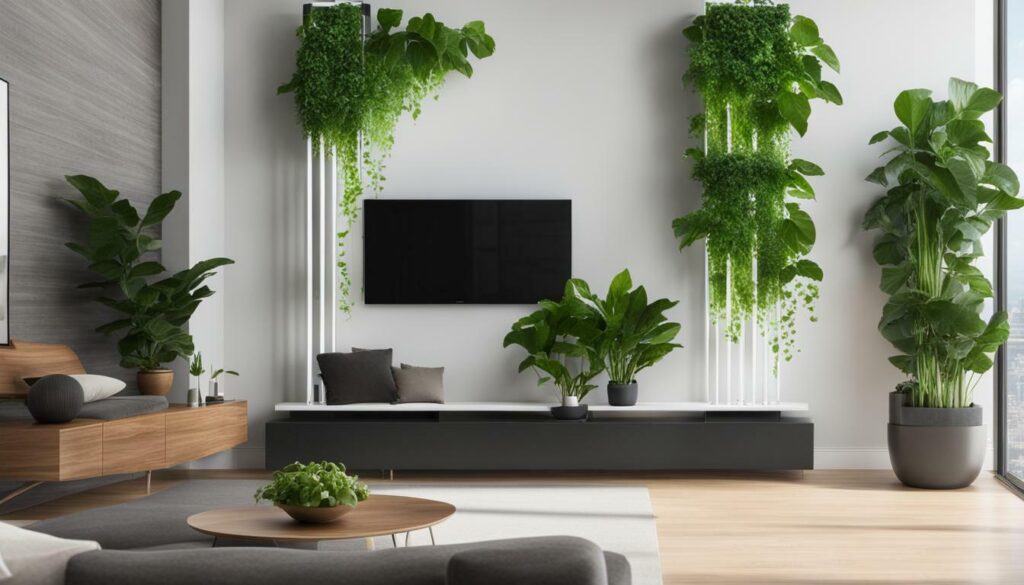
Conclusion
Vertical hydroponic systems offer a range of advantages, including efficient space utilization, customization options, and sustainable farming practices, making them an ideal choice for indoor gardeners seeking superior growth.
One of the key benefits of vertical hydroponic systems is their ability to optimize limited space. With vertical systems, growers can make the most of small indoor or outdoor areas, such as corners of rooms or even against outdoor patio walls. This efficient use of space is particularly beneficial for urban gardening, where floor space is often limited.
Another advantage of vertical hydroponics is the lack of soil. By eliminating the need for soil, growers can overcome challenges such as soil erosion and water scarcity. This innovative alternative approach to agriculture allows for the cultivation of crops in areas with little arable land or dry/arid climates. Additionally, the absence of soil reduces the spread of weeds, pests, and plant diseases, resulting in a decreased reliance on chemical fertilizers and pesticides.
Efficiency and productivity are also key benefits of vertical hydroponic systems. By delivering nutrient-rich solutions directly to plant roots, these systems ensure optimal nutrition uptake, resulting in faster growth rates and maximized crop yields. The controlled environments provided by indoor vertical hydroponics further enhance productivity, allowing for year-round cultivation and the ability to grow a wide range of crops.
Lastly, vertical hydroponics offers low maintenance requirements. With closed-loop systems that recycle water and minimize wastage, these systems are environmentally friendly and water-efficient. They conserve up to 80% of water compared to traditional garden beds, making them a sustainable option, especially in regions facing water shortage concerns. The minimal maintenance required for vertical hydroponics is an added benefit, allowing growers to focus more on crop management and less on labor-intensive tasks.
In conclusion, vertical hydroponic systems provide numerous advantages for indoor gardeners. From efficient space utilization and customization options to sustainable farming practices, these systems offer a superior growth solution for growing a variety of crops. Whether you choose to purchase a pre-made system or embark on a DIY project, vertical hydroponics is a promising approach to achieve optimal yields in a controlled and sustainable indoor environment.
What Makes the Exo Vertical Hydroponic Garden Tower System Superior for Indoor Gardening?
The Exo Vertical Hydroponic Garden Tower System offers a superior solution for indoor gardening with its ability to maximize growth. This innovative system utilizes hydroponic techniques to provide a controlled environment, allowing plants to thrive without soil. With the tower design, it maximizes space efficiency, making it perfect for small indoor areas. The use of hydroponics ensures optimal nutrient delivery, promoting faster growth and higher yields. The Exo Vertical Hydroponic Garden Tower System truly stands out as a game-changer in indoor gardening.
FAQ
Q: What are the advantages of vertical hydroponics?
A: Vertical hydroponics offers space savings, eliminates the need for soil, increases efficiency and productivity, and requires low maintenance.
Q: How does vertical hydroponics save space?
A: By utilizing vertical systems, plants can be grown in small indoor or outdoor spaces, maximizing the usage of limited area.
Q: How does vertical hydroponics eliminate the need for soil?
A: Vertical hydroponics allows crops to be grown without soil, which is beneficial for areas with limited arable land, dry/arid climates, and soil erosion issues. It also reduces the use of chemical fertilizers, fungicides, and pesticides.
Q: How does vertical hydroponics increase efficiency and productivity?
A: By delivering nutrient-rich solutions directly to plant roots, vertical hydroponics ensures optimal nutrition and eliminates the need for plants to search for nutrients in soil. This results in faster growth rates, higher quality, and increased yields.
Q: Is vertical hydroponics low maintenance?
A: Yes, vertical hydroponics systems are designed to be low maintenance. The water and nutrients are contained within the system, minimizing spillage and wastage. Additionally, recirculating hydroponic systems conserve water and reduce the need for constant watering.
Q: What are the challenges in water flow in vertical hydroponics?
A: The main challenge is ensuring that water, nutrients, and light reach plants on all levels of the system. Pumps with higher power are required to deliver water to the top against gravity, and adequate lighting is necessary for indoor systems.
Q: Should I buy a pre-made system or build my own?
A: The decision between buying a pre-made system or building your own depends on factors such as technical ability, available time, budget constraints, and customization preferences. Pre-made systems offer convenience and support, while DIY projects provide creative freedom and cost-effectiveness.
Q: What plants are best suited for vertical hydroponic systems?
A: Vertical hydroponic systems are well-suited for a variety of plants, but crops such as leafy greens and herbs thrive particularly well in these setups. The ability to customize conditions, such as lighting and humidity, allows for optimal growth of these crops.
Q: What are the advantages of vertical hydroponics compared to traditional soil-based methods?
A: Vertical hydroponics offers up to 6 times higher yields compared to traditional soil-based methods due to its efficient space utilization. It also provides greater control over growth conditions, promotes sustainability through closed-loop water systems, and reduces the risk of pests and diseases.

